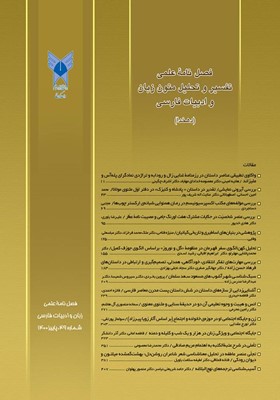جایگاه اجتماعی و ویژگی زنان در هزارویک شب و کلیله و دمنه
محورهای موضوعی : متون زبان و ادبیات فارسیفاطمه امانی 1 , آذر دانشگر 2 * , زهرا دری 3 , ماه نظری 4
1 - دانشجوی دکتری گروه زبان و ادبیات فارسی، واحد کرج، دانشگاه آزاد اسلامی، کرج، ایران.
2 - استادیار گروه زبان و ادبیات فارسی، واحد کرج، دانشگاه آزاد اسلامی، کرج، ایران.
3 - گروه زبان و ادبیات فارسی، واحد کرج، دانشگاه آزاد اسلامی ،کرج، ایران.
4 - گروه زبان و ادبیات فارسی، واحد کرج، دانشگاه آزاد اسلامی ،کرج، ایران.
کلید واژه: خیانت, جایگاه اجتماعی, کلیله و دمنه, هزارویک شب, زنان,
چکیده مقاله :
در آثار ادبی، متون کهن و قصه ها زنان به عنوان بخشی از جامعه نقش ها و ویژگی های گوناگونی داشته اند. تالیف و نوشته شدن این آثار توسط مردان و پرداختن به زن و جایگاه اواز دیدگاه آن ها از مهم ترین ویژگی های این متون است. هزارویک شب و کلیله و دمنه به عنوان دو اثرداستانی بازگو کنندۀ بسیار خوبی برای بیان جایگاه زنان و موقعیت آنان در جوامع کهن هستند. زنان در قصه های این دواثر ویژگی، نقش و جایگاه گوناگونی داشته و بیان خصوصیات منفی و مثبت در مورد آن ها زیاد است. در این مقاله با روش توصیفی – تحلیلی، به مقایسه و بیان خصوصیات، جایگاه و نقش اجتماعی زنان در قصه های هزارویک شب و کلیله و دمنه پرداخته شده است. نتایج این پژوهش گویای آن است که توجه هرچه بیشتر به خصوصیات منفی زنان در قصه های هزارویک شب و کلیله و دمنه نشان دهندۀ نوع نگاه نویسندگان مرد دریک جامعه مردسالار نسبت به زنان و جایگاه آن هاست. در قصه های هزارویک شب خیانتگری زنان حتی در برترین جایگاه و مقام یعنی ملکه و همسر پادشاه موضوع اصلی و آغاز کننده داستان ها بوده است، اما در داستان های کلیله و دمنه این ویژگی به زنان در طبقات دیگر جامعه اختصاص داده شده است. سایر خصوصیات مثبت و منفی همچون تدبیر، دانش، خرد، شجاعت، حیله گری و نیرنگ بازی همه از مواردی است، که در داستان های دو کتاب هزارویک شب و کلیله و دمنه به زنان نسبت داده شده است.
In literary works, ancient texts and stories, women have had various roles and characteristics as part of society. Compilation of these works by men and addressing women and their position from their point of view is one of the most important features of these texts. The books of One Thousand and One Nights and also Kelileh va Demneh, as two ancient fictional works that have many stories in them, are very good narrators to express the position of women and their position in ancient societies. Women have different characteristics, roles and positions in the stories of these two works, and there are many negative and positive characteristics about them. In this article, with a descriptive-analytical method, the characteristics, position and social role of women in the tales of One Thousand and One Nights and Kelileh va Demneh have been compared and expressed. The results of this study show that more and more attention to the negative characteristics of women in the stories of One Thousand and One Nights and Kelileh va Demneh shows the view of male writers in a patriarchal society towards women and their position. In the tales of One Thousand and One Nights, the betrayal of women in the highest position, that is, the queen and the king's wife, has been the main and beginning of the stories, but in the stories of Kelileh and Demneh, this feature has been attributed to women in other classes of society. Other positive and negative characteristics such as tact, knowledge, wisdom, courage, cunning and trickery are all items that have been attributed to women in the stories of both Thousand and One Nights and Kelileh va Demneh.

